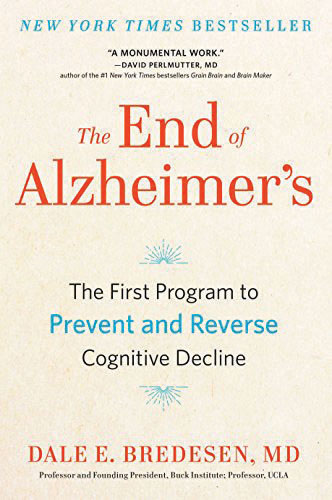The Case For an Individualized Approach to Alzheimer’s

The End of Alzheimer’s: The First Program to Prevent and Reverse Cognitive Decline
By Dale E. Bredesen, M.D.
Penguin Random House, 2017
$27 hardback/$16.06 paperback
Dale Bredesen has been on the trail of Alzheimer’s Disease for his entire career. In the 1990s, he studied cell cultures of brain cells in the lab, and for years, was looking for a magic pill — that’s what everyone wants. But his wife is a functional medicine practitioner, and addresses the underlying causes of disease using a systems-oriented approach. She told him any solution to Alzheimer’s would have to take that tack, and be adjusted to each patient’s individual conditions. Ten years later, that’s what he found himself doing.
In The End of Alzheimer’s: The First Program to Prevent and Reverse Cognitive Decline, Bredesen lays out his case for a whole-body approach to the disease. His protocol consists of a battery of lab tests, combined with interviews, consideration of lifestyle, home environment, social factors, dentistry, leaky gut, mineral imbalances, hormone imbalances, sleep and more.
Some studies estimate that 25 percent of all deaths of age-related disease are really Alzheimer’s, and that the disease is growing, as cancer and cardiovascular disease are ever-so-slowly waning. According to the Alzheimer’s Association, it is the sixth-leading cause of death in the United States.
Bredesen contends that his approach has had some spectacular successes with people who are far along the path to oblivion, restoring their ability to function, and returning them to their homes and their jobs. He believes there is no longer any need for anyone to suffer symptoms of Alzheimer’s, and that, if started early, his program will prevent the disease from developing.
I believe Bredesen has given us a generalized anti-aging protocol, perhaps the most credible system that we have at present. Furthermore, he offers a new paradigm for medical research. We have been dependent far too long on drug companies focusing on a single, patentable drug at a time. We need to be creating and testing entire protocols for integrated diagnosis and individualized treatment programs.
This search for a cure-all has been the primary factor slowing the acceptance of Bredesen’s work. Who knows what other breakthroughs will come to light once we steer away from that path?
More information can be found at DrBredesen.com.
